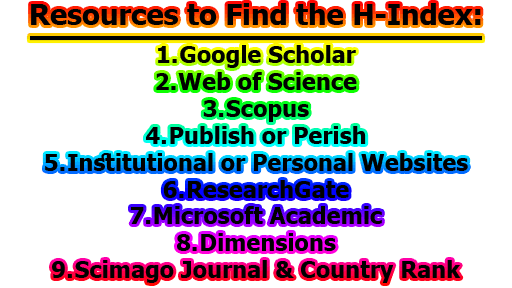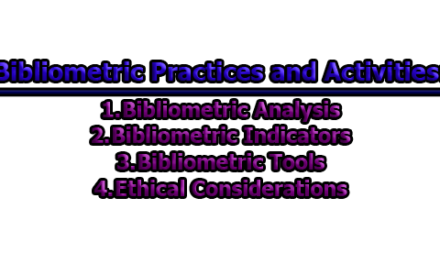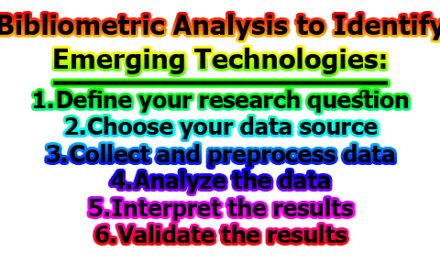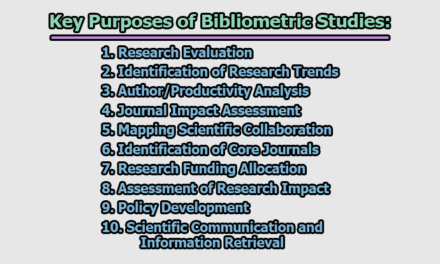The h-index is a quantitative metric used to measure the productivity and impact of a researcher’s published work. It was proposed by physicist Jorge Hirsch in 2005 and is now widely used in academic circles. The h-index is based on the number of publications and the number of citations those publications have received. Specifically, an author has an h-index of h if they have h publications that have been cited at least h times each. For example, an author with an h-index of 10 has published at least 10 papers that have each been cited at least 10 times. This indicates that their work has had a significant impact and has been recognized by their peers in the field. The h-index is just one of many metrics used to evaluate academic productivity and impact, and it has its limitations. It does not take into account the quality of the publications or the context in which they were published. Additionally, the h-index can vary significantly between fields, with some fields having higher h-index values than others. In the rest of this article, we are going to know about useful for the h-index, not useful for the h-index, calculate manually h-index, resources to find the h-index, strengths, and shortcomings of the h-index.
Definitions of H-Index:
Here are three different definitions of the h-index, each from a different writer’s perspective:
From the perspective of a Bibliometrician: The h-index is a measure of an author’s impact based on the number of papers they have published and the number of citations those papers have received. The h-index is the largest number of h such that the author has h papers that have each been cited at least h times. For example, an author with an h-index of 20 has published 20 papers that have each been cited at least 20 times.
From the perspective of a Scientist: The h-index is a way to quantify the impact and productivity of a scientist’s research. It reflects both the number of papers they have published and the impact those papers have had on their field. A high h-index indicates that a scientist has published a large number of highly cited papers, which is often seen as a sign of excellence in research.
From the perspective of a Hiring Committee: The h-index is a quick and easy way to evaluate the impact and productivity of a job candidate’s research. While it has some limitations, such as its susceptibility to bias and its inability to measure the relevance of individual papers, it provides a standardized metric that can be used to compare candidates from different fields of study. A high h-index may be seen as a positive indicator of a candidate’s potential to contribute to the department’s research mission.
Useful For H-Index:
The h-index can be useful in several ways:
i. Evaluating individual researchers: The h-index can provide a quantitative measure of a researcher’s productivity and impact, which can be useful in evaluating their contributions to the field.
ii. Comparing researchers: The h-index can be used to compare researchers in the same field or across different fields, providing a standard metric for evaluating their productivity and impact.
iii. Grant applications and job applications: The h-index can be used as a metric in grant applications and job applications to provide evidence of a researcher’s productivity and impact.
iv. Identifying influential publications: The h-index can be used to identify a researcher’s most influential publications, which can be useful for understanding the impact of their work on the field.
v. Benchmarking research institutions: The h-index can be used to compare the productivity and impact of research institutions, providing a useful benchmark for evaluating their performance.
Not Useful For H-Index:
While the h-index can be a useful metric for evaluating research productivity and impact, it has some limitations and may not always be the best measure to use. Here are some situations where the h-index may not be useful:
i. Early career researchers: The h-index may not be the best measure for evaluating early career researchers who have not yet had time to build up a significant publication and citation record.
ii. Interdisciplinary research: The h-index may not be well-suited for interdisciplinary research, where publications may be cited in different fields or have different levels of impact in each field.
iii. Different publication formats: The h-index is primarily based on journal articles, but it may not take into account other types of publications, such as books, book chapters, conference proceedings, or patents.
iv. Self-citations: The h-index can be influenced by self-citations, which may inflate the number of citations a researcher has received.
vi. Citation practices: The h-index can be influenced by citation practices within a field, such as a tendency to cite older publications or highly cited publications, which may not reflect the true impact of a researcher’s work.
vi. Quality of citations: The h-index does not take into account the quality or relevance of the citations a publication has received, which can vary widely even for highly cited publications.
Calculate Manually H-Index:
The h-index is a measure of an author’s productivity and impact in their field. It is defined as the maximum number of h such that an author has published h papers that have each been cited at least h times. To calculate the h-index manually, follow these steps:
- Make a list of the author’s publications in descending order by the number of citations each paper has received.
- Count down the list until the number of publications matches or falls below the number of citations.
- The h-index is the number of papers in the list that have been cited at least as many times as their rank.
For example, suppose an author has published the following papers, with their corresponding number of citations:
Paper 1: 50 citations
Paper 2: 30 citations
Paper 3: 25 citations
Paper 4: 20 citations
Paper 5: 15 citations
Paper 6: 10 citations
Paper 7: 5 citations
To calculate the h-index:
a. Sort the papers by citation count:
Paper 1: 50 citations
Paper 2: 30 citations
Paper 3: 25 citations
Paper 4: 20 citations
Paper 5: 15 citations
Paper 6: 10 citations
Paper 7: 5 citations
b. Count down the list until the number of the publication matches or falls below the number of citations:
Paper 1: 50 citations (h=1)
Paper 2: 30 citations (h=2)
Paper 3: 25 citations (h=3)
Paper 4: 20 citations (h=4)
Paper 5: 15 citations (h=5)
Paper 6: 10 citations (h=6)
Paper 7: 5 citations (h=7)
c. The h-index is the number of papers in the list that have been cited at least as many times as their rank. In this case, the h-index is 5, because the first five papers on the list have been cited at least 5 times.
Therefore, the h-index of this author is 5.
Resources to Find the H-Index:
There are several resources you can use to find an author’s h-index. Some of them are briefly given below:
- Google Scholar: This is one of the most commonly used tools for finding an author’s h-index. Simply enter the author’s name in the search box, and click on their profile in the search results. The h-index will be displayed on their profile page, along with other metrics such as the total number of citations and the number of papers they have published.
- Web of Science: This is another popular tool for finding an author’s h-index. Web of Science is a subscription-based citation database that indexes a wide range of scientific and scholarly publications. To find an author’s h-index, search for their name in the database, and click on the “Author Search” tab. The h-index will be displayed in the author’s profile.
- Scopus: Scopus is a large abstract and citation database that covers a wide range of scientific and scholarly publications. Like the Web of Science, it requires a subscription to access. To find an author’s h-index, search for their name in the database, and click on the “Author Details” link. The h-index will be displayed along with other metrics such as the total number of citations and the number of papers they have published.
- Publish or Perish: This is a free software program that can be used to calculate an author’s h-index based on data from Google Scholar. To use the software, you will need to download it from the official website and enter the author’s name into the search box. The software will then generate a report that includes the author’s h-index, along with other metrics such as the g-index and the h-core.
- Institutional or personal websites: Some institutions or authors may list their h-index on their websites, particularly if they have a significant impact in their field. You can search for an author’s website using their name and institution or organization.
- ResearchGate: ResearchGate is a social networking site for researchers and scientists, where they can share their work and connect with other researchers. It also provides an author metric called RG Score, which is similar to the h-index. To find an author’s RG Score, search for their name in the search box, and click on their profile. The RG Score will be displayed along with other metrics such as the total number of citations and the number of publications.
- Microsoft Academic: Microsoft Academic is a free search engine for academic publications. It provides an author metric called the “Composite Citation Index”, which is similar to the h-index. To find an author’s Composite Citation Index, search for their name in the search box, and click on their profile. The Composite Citation Index will be displayed along with other metrics such as the total number of citations and the number of publications.
- Dimensions: Dimensions is a free search engine for academic publications that provides a range of author metrics, including the h-index. To find an author’s h-index, search for their name in the search box, and click on their profile. The h-index will be displayed along with other metrics such as the total number of citations and the number of publications.
- Scimago Journal & Country Rank: Scimago Journal & Country Rank is a free online tool that provides a range of metrics for academic journals and countries. It also provides an author metric called the “Hirsch index”, which is similar to the h-index. To find an author’s Hirsch index, search for their name in the search box, and click on their profile. The Hirsch index will be displayed along with other metrics such as the total number of citations and the number of publications.
Strengths of the H-Index:
Here are some strengths of the h-index:
- Takes into account both the quantity and quality of an author’s publications, giving credit to authors who have published a large number of highly cited papers.
- Provides a standardized metric that can be used to compare the impact of authors in different fields of study.
- Is relatively easy to calculate and understand, making it a popular metric for evaluating an author’s impact.
- Is less susceptible to the impact of outlier papers than other metrics such as the total number of citations.
- Reflects the author’s entire career, rather than just their most recent work.
- Can be used to track an author’s progress over time, providing a measure of their growth and development as a researcher.
- Can be used to identify highly cited papers or areas of research, which can be useful for identifying emerging trends or potential collaborations.
- Can be used to evaluate the impact of individual authors, research groups, or entire departments.
- Can be used to evaluate the impact of authors who work in areas with relatively low citation rates.
- Is widely used and recognized by the academic community, making it a valuable tool for career advancement and grant applications.
Shortcomings of the H-Index:
Here are some shortcomings of the h-index:
- Ignores the relevance or impact of an individual paper. The h-index is based solely on the number of citations an author’s papers have received, without taking into account the impact or importance of each paper.
- Can be influenced by self-citations or co-authorship. The h-index can be inflated by authors who cite their own work or collaborate with other highly cited authors.
- Does not take into account the age of an author’s publications. The h-index does not distinguish between older and more recent publications, which may have different levels of impact or relevance.
- Can be biased towards authors who have been publishing for a longer time. The h-index is biased towards authors who have been publishing for a longer time, as they have had more opportunities to accumulate citations.
- Does not account for variations in citation practices across disciplines. The h-index may not be comparable across different fields of study, as some disciplines have higher citation rates than others.
- May not reflect an author’s current level of activity or impact. The h-index is a cumulative measure, which means that an author’s current level of activity or impact may not be accurately reflected.
- May not be a reliable measure for early-career researchers. The h-index may not be a reliable measure for early-career researchers, who may not yet have had the opportunity to accumulate a large number of citations.
- May not account for different types of publications. The h-index does not distinguish between different types of publications, such as books, book chapters, or conference proceedings.
- Can be influenced by the availability and accessibility of an author’s work. The h-index may be influenced by factors such as the availability and accessibility of an author’s work, which may vary across different countries or institutions.
- May not be the best metric for evaluating the impact of interdisciplinary or collaborative research. The h-index may not be the best metric for evaluating the impact of interdisciplinary or collaborative research, as it is based on individual authorship and does not account for team-based research.
From the above discussion, we can say that the h-index is a widely used metric for evaluating the impact and productivity of researchers. It takes into account both the quantity and quality of an author’s publications, providing a standardized measure of the impact that can be compared across different fields of study. However, the h-index also has some limitations and shortcomings, such as its inability to measure the relevance or impact of individual papers and its susceptibility to bias and variation across disciplines. As with any metric, it is important to use the h-index in conjunction with other measures of impact and productivity to get a more complete picture of a researcher’s contributions to their field. Overall, the h-index remains a valuable tool for evaluating academic research but should be used with caution and in combination with other metrics to ensure a more comprehensive assessment of a researcher’s impact.

Assistant Teacher at Zinzira Pir Mohammad Pilot School and College










